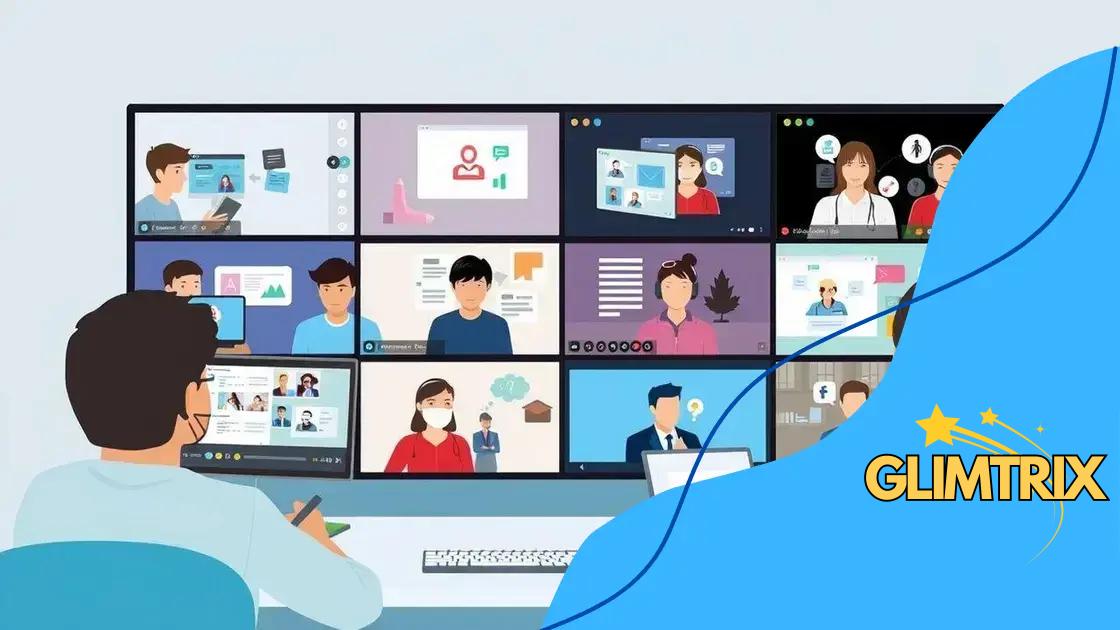The impact of virtual classrooms on student collaboration

The impact of virtual classrooms on student collaboration enhances communication, promotes teamwork through advanced tools, and requires schools to address challenges like technical issues and engagement effectively.
The impact of virtual classrooms on student collaboration is reshaping how students work together and engage with educational content. Have you noticed how technology changes our learning dynamics? Let’s explore the influence of these digital spaces.
Understanding virtual classrooms
In today’s world, understanding virtual classrooms is crucial for both students and educators. These online platforms redefine how learning takes place by providing flexible and accessible environments for collaboration. They allow students from different locations to connect, share ideas, and work together.
What Are Virtual Classrooms?
A virtual classroom is essentially a digital space where teaching and learning occur through the internet. They use a combination of video conferencing, chat, and shared digital tools to create an interactive experience. This setup can mirror traditional classrooms while offering unique benefits.
Benefits of Virtual Classrooms
- Flexibility: Students can learn from anywhere with an internet connection.
- Accessibility: It provides opportunities for those who may struggle to attend in-person classes.
- Engagement: Interactive tools promote active participation among students.
This flexibility means that learning is no longer bound to specific times or locations. Students can attend classes from home, the library, or even while traveling. This option often leads to increased attendance and retention rates.
Moreover, technology in virtual classrooms enhances the learning experience. Tools like shared documents allow students to collaborate on projects in real-time. They can easily communicate ideas, leading to richer discussions and a deeper understanding of content.
Challenges to Consider
Despite their benefits, there are challenges to using virtual classrooms. Some students may feel isolated, missing the social interactions found in traditional settings. Additionally, technical issues can disrupt learning. These hurdles highlight the importance of effective support and resources.
As educators embrace virtual classrooms, understanding how to create an inclusive and engaging environment is essential. By leveraging technology while addressing challenges, we can maximize the benefits of online learning.
Benefits of collaboration in virtual settings
Understanding the benefits of collaboration in virtual settings is essential in today’s educational landscape. Collaborative learning not only enhances individual performance but also fosters teamwork and communication among students.
Enhanced Interaction
In virtual classrooms, students can interact with their peers in various ways. They can use chat functions, video calls, or discussion boards to share ideas and feedback. This variety keeps students engaged and allows for a richer learning experience.
Access to Diverse Perspectives
- Global Collaboration: Students can work with peers from different cultures.
- Variety of Skills: Group projects can combine diverse skill sets and knowledge.
- Innovative Solutions: Collaborating fosters creativity and out-of-the-box thinking.
Working alongside classmates with different backgrounds opens up new points of view. This collaboration encourages students to think critically about their own ideas while considering others. It can lead to innovative solutions and a deeper understanding of subjects.
Moreover, technology facilitates easy access to resources and tools. Students can share files, collaborate on presentations, and conduct research together in real-time. This seamless exchange of information reinforces the learning process and prepares students for future workplaces.
Improved Social Skills
Through collaboration in virtual settings, students practice essential social skills like communication, conflict resolution, and teamwork. Engaging with peers prepares them for real-life interactions in professional environments.
These experiences build their confidence in expressing ideas and working as part of a team. As a result, students emerge from virtual classrooms not only with knowledge but also with vital interpersonal skills.
Tools that promote teamwork online

In virtual classrooms, using the right tools that promote teamwork online is vital for effective collaboration. These tools enable students to communicate, share ideas, and work together seamlessly, enhancing their learning experience.
Popular Collaboration Tools
Many tools are designed to support teamwork in virtual settings. For example, platforms like Google Workspace allow multiple users to work on documents simultaneously. This feature enables real-time collaboration, making it easy for students to brainstorm and edit together.
- Microsoft Teams: Integrates chat, video calls, and file sharing.
- Slack: Facilitates organized conversations through channels and direct messages.
- Trello: Helps organize projects with boards and cards for task management.
These platforms enhance communication and keep projects organized. Using such tools, students can easily assign tasks, set deadlines, and track progress. This structure fosters a sense of accountability and encourages everyone to contribute.
Benefits of Online Tools
The right online tools can improve teamwork by breaking down communication barriers. Students can express their ideas freely, regardless of their physical location. This aspect is crucial for creating an inclusive environment where everyone feels valued.
Moreover, collaboration tools can also record interactions. This feature allows students to refer back to discussions and decisions made during group work. It promotes transparency and helps keep all members on the same page, regardless of differences in schedules.
As students become more adept at using these tools, they not only enhance their current learning but also prepare for future workplaces where such technologies are standard. Thus, integrating these discussions into education creates a robust foundation for collaborative skills.
Challenges in virtual collaboration
While virtual collaboration offers many advantages, there are also notable challenges in virtual collaboration that can impact the learning experience. Understanding these challenges can help students and educators find effective solutions.
Communication Barriers
One common issue is the lack of face-to-face interaction. Without physical cues, students may misinterpret messages. This can lead to confusion or frustration during group projects. To combat this, using video conferencing can help enhance communication by allowing participants to see each other.
Technical Issues
Technical difficulties can arise in virtual settings. Problems such as poor internet connections, software glitches, and unfamiliarity with tools may disrupt collaboration. To minimize these disruptions, it is essential for students to familiarize themselves with the chosen software and ensure they have a reliable internet connection.
- Inadequate Resources: Not all students have access to reliable devices or high-speed internet.
- Time Zone Differences: Collaborating across different time zones can complicate scheduling.
- Distractions: Home environments may have more distractions compared to a traditional classroom setting.
Each of these challenges can hinder the effectiveness of teamwork. However, schools can provide support by ensuring all students have the necessary resources and offering training on effective communication tools.
Maintaining Engagement
Keeping all members engaged during virtual collaboration can be difficult. Some students may feel isolated or unmotivated when participating online. To address this, instructors can assign roles within a group, ensuring that everyone has a clear responsibility. This approach promotes accountability and helps students stay engaged.
Additionally, incorporating interactive elements like polls or breakout sessions can keep students actively involved in discussions. Using varied engagement strategies can make virtual collaboration more dynamic and enjoyable.
Future trends of virtual learning environments
The future trends of virtual learning environments are evolving rapidly, influenced by technological advancements and changing educational needs. As we look ahead, several key trends are likely to shape how students learn and collaborate online.
Increased Use of Artificial Intelligence
Artificial intelligence (AI) is set to play a larger role in virtual classrooms. AI can provide personalized learning experiences tailored to individual student needs. For example, adaptive learning platforms can analyze a student’s performance and adjust the curriculum accordingly.
- Smart Tutoring Systems: These AI systems offer assistance based on the learner’s pace and level.
- Automated Administrative Tasks: AI can help reduce teachers’ workloads by automating grading and feedback.
- Predictive Analytics: AI tools can identify students at risk of falling behind, allowing for timely intervention.
This integration of AI can enhance learning outcomes and make education more efficient.
Incorporating Virtual Reality and Augmented Reality
Another exciting trend is the integration of virtual reality (VR) and augmented reality (AR) into learning environments. These technologies can create immersive experiences that engage students in ways traditional methods cannot.
For instance, using VR in a history class could allow students to explore ancient civilizations firsthand. AR can bring static images to life, making complex subjects more understandable and enjoyable. These tools foster deeper engagement and enhance understanding of concepts.
Focus on Social Emotional Learning
As virtual learning becomes more prevalent, there is a growing recognition of the importance of social emotional learning (SEL). Educators are starting to understand that while technology is essential, nurturing emotional intelligence remains crucial.
Future virtual classrooms will likely include components aimed at fostering relationships, self-management, and decision-making skills among students. Using online platforms to promote team-building activities may help address feelings of isolation and encourage community.
Emphasis on Lifelong Learning
The future will also see an increased emphasis on lifelong learning. As the job market continues to evolve, individuals will need to adapt by continually updating their skills. Virtual learning environments will serve as platforms for ongoing education for all age groups.
These trends indicate a promising future for education. By adapting to technological advancements and emphasizing core emotional and social skills, virtual learning environments can support the diverse needs of learners today and tomorrow.
FAQ – Frequently Asked Questions about Virtual Classrooms and Collaboration
What are the main benefits of virtual classrooms for collaboration?
Virtual classrooms enhance collaboration by allowing students to interact from anywhere, use interactive tools, and access diverse perspectives.
How do technology tools facilitate teamwork in virtual settings?
Tools like Google Workspace, Microsoft Teams, and Trello promote teamwork through real-time communication, task management, and shared resources.
What are some common challenges in virtual collaboration?
Common challenges include communication barriers, technical issues, and maintaining student engagement during virtual sessions.
How can schools address the challenges of virtual learning?
Schools can provide training on tools, offer technical support, and focus on social-emotional learning to create a supportive environment.





